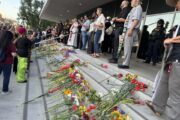South Korea has become most widely known for its rapidly growing Christian population in the recent past, but nearly a quarter of the country’s population identify as Buddhist. (A majority of the entire country’s population—47 percent—identifies as religiously unaffiliated.) When we went to Seoul last fall, it was thus only appropriate for our research team to get a glimpse of the diversity of Buddhist religious expression in the country and its potential innovations.
Buddhist temples in South Korea are traditionally confined to the mountainous regions of the country. In fact, Buddhist monks were forbidden to enter the capital during the Joseon Dynasty when Confucianism became the sole official religion of the state. There are, however, a few exceptions. Jogyesa temple, the headquarters of the Jogye order of Korean Seon (Zen) Buddhism, is centrally located in the busting metropolis of Seoul. Although the temple was first established in the 14th century, the modern temple structure was founded in 1910 during the period of Japanese rule of the country.
(Click on any photo to go to Instagram, and find more photos at #ReligioninSeoul.)
At first glance, Jogyesa temple with its ornate temple décor, Buddhist symbols and and ritualism, strikes one as emblematic of “traditional” Korean Buddhism. And indeed, this was how the temple’s English-speaking volunteer guides introduced the temple to us foreign visitors. However, this idea of “traditional” belies certain key innovative efforts—both historical and contemporary—that help sustain the temple and the larger Jogye order into the 21st century among competing religious forces.
The multi-tiered stupa (pagoda) located at the center of the sprawling temple premises provides a glimpse into one strand of innovation. Buddhist pagodas are towering structure found commonly across the Buddhist Asia world where sacred relics, often of the Buddha himself or of his disciples, are kept safe and venerated. Jinsinsari, the pagoda in Jogyesa, is said to store an aspect of the historical Sakyamuni Buddha’s body gifted to the temple in 1913 by the prominent Sri Lankan Theravada Buddhist Anagarika Dharmapala. He had received the relic by the then Theravada King of Thailand. Korea was one of Dharmapala’s stops on a pan-Asia tour from Japan to Indonesia.
Dharmapala’s gift to the Korean temple is more than the story of the inter-regional historical ties between different Buddhist cultures and sects of Asia. It also speaks to the broader Buddhist revivalist movement in Asia at the turn of the 20th century. Such exchanges in relics and amulets helped consolidate a disparate cosmopolitan network of Buddhist centers across Asia, primarily as a response to what many saw as the erosion of the Buddhist institutional establishment due to the rising prominence of Christian missionaries in Asia.
Fast-forward a century, and we find a new dynamic of religious flux in the works, particularly the decline of Christianity in the West, coupled with an increasing interest among Westerners in Buddhist meditation techniques as a mode of relaxing and connecting with the calm and peace within oneself. Korean Buddhist institutions have been quick to keep up with these global religious trends, creating new ways to engage Westerners and young Korean who look towards the contemplative tradition of Buddhism as a means to cope with the agitation of modern society.
One of these new adaptations is the idea of “temple stays.” Begun in 2002, temple stay programs have become one of the country’s most successful tourism initiatives. Operated by the Jogye Order of Korean Buddhism, a temple stay allows Koreans and foreigners alike to experience—for a night or longer, depending on their preference—life as a monastic in the serene mountains of Korea. Promoted as both a glimpse into “traditional Korean culture” and as an escape from the busyness of modern city life, temple stay programs, I suspect, offer Buddhist temples a lifeline in a country that is rapidly becoming more Christian.
As one of few Buddhist temples in Seoul, Jogyesa attracts a good number of tourists. It also encourages tourists to stay at rural temples. A young Buddhist nun, who led our research team through the slow ritualistic and meditative method of drinking a fragrant cup of lotus and jasmine tea, encouraged us to attend a temple stay program to catch a glimpse into “traditional Korean culture.”
The brightly painted temple in the midst of skyscrapers isn’t just a reminder of days passed; rather it is an example of how religious institutions respond to competition and religious flux with innovation.
Nalika Gajaweera was a senior research analyst with the USC Center for Religion and Civic Culture through 2023.







